Intel Processor Comparison Chart i3, i5, i7, i9
Intel processors have been differentiated in the i3, i5, i7, and i9 product lines for ages, but what exactly is behind them? Here we explain the most important properties of all Intel CPUs and introduce you to the intel processor comparison chart i3, i5, i7, and i9 for every price range.
You will also learn how Intel processors differ, how you can read the model name and which processor series is suitable for which purpose. Because if you buy wildly, you are definitely choosing the wrong Intel CPU. And although AMD has caused a lot of wind with its Ryzen CPUs, Intel processors still belong in every CPU ranking.
Intel Processor Comparison Chart i3, i5, i7, i9 : Overview And General Differences
Before we go into the details for the individual Intel processors, we would like to introduce you to the rough differences and application areas of the various model series. The following table summarizes the most important things:
| Property | i3 | i5 | i7 | i9 |
|---|---|---|---|---|
| Power | low | medium | high-very high | very high |
| Operation Area | Casual gaming, office work, surfing | Serious gaming, video editing (but with limitations) | High-end gaming, video rendering without restrictions | Everything is possible, especially gaming & streaming etc. at the same time |
| Price | low | medium | high | extremely high |
| Cores | up to 4 | up to 6 | up to 8 | 8-18 (X row) |
| Threads | up to 4 | up to 12 | up to 8 | 8-18 (X row) |
| Cache | Max 8 MB | Max 12 MB | Max 16 MB | Max 20 MB |
As you can see, the Intel processors differ from “small” (i3) to “large” mainly in terms of their performance potential and price. However, the individual processors still have a few details, which we will now briefly discuss.
Understand Model Names And Generations
But before we go into the specifics you should understand how to “read” the processor names of Intel CPUs.
As you can see in the picture above, this is quite easy. Using the example of the Intel Core i5-8700K, we can easily see what an Intel CPU can actually do and where it belongs:
- The first part always describes the processor type (Intel Core series) and the processor type (i5).
- In this case, the first number describes the processor generation, the 8th – the larger this number, the newer the CPU.
- The model number follows this. The following applies here: The higher this is, the more powerful the CPU is.
- Finally, various suffixes such as K, HK, T, which characterize the CPU’s special properties. We’ll explain these in a moment.
The following names refer to the desktop CPUs from Intel, corresponding processor generations can be enumerated as follows:
- Nehalem
- Sandy Bridge
- Ivy Bridge
- Haswell
- Broadwell
- Skylake
- Kaby Lake
- Coffee Lake
- Coffee Lake Refresh
- Comet Lake
We also want to list the most important suffixes below :
- A K at the end means that the CPU is overclockable (unlocked)
- G or G1-G7: CPU contains an integrated graphics unit. In the case of processors with an integrated GPU, the model is referred to here
- Q: Without an integrated GPU
- H: High performance, optimized for mobile processors
- HK: high performance and overclockable (mobile processors)
- HQ: high performance for laptops, four cores
- S: special edition
- T: Energy-efficient CPU desktop
- U: energy efficient (mobile)
- Y: Extremely energy-saving (mobile)
- X: Extreme series for high-end desktop PCs and workstations
Now that you understand Intel processors’ names let’s get into the series’ specifics.
Intel Core i3 Processors
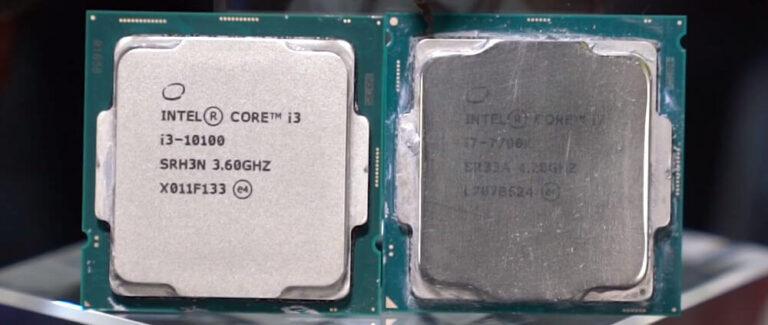
We start at the bottom and work our way up. The Core i3 is the budget processor from Intel. Although Core i3 processors are the cheapest and slowest of the Core family, they are still suitable for basic applications and casual gaming.
The technology behind Core i3 processors in the current 10th generation comprises a four-core basis (older generations only had 2 processor cores here), Hyper-Threading support, and virtualization. Core i3 processors also support 64-bit versions of Windows.
However, there are also a few restrictions here. For example, the Core i3 processors do not support Intel’s Turbo Boost technology and have less cache than their Core i5, Core i7, and Core i9. The cache is an important specification that enables the processor to perform certain tasks more efficiently.
Accordingly, the Intel Core i3 is ideal for everyone who needs less power. Because although i3 CPUs are now quite high-performance, their performance is insufficient for demanding games or computing-intensive applications. Therefore, this CPU series is best suited for entry-level PCs used for e-mails, word processing, light gaming, and simple Internet surfing.
Intel Core i5 Processors
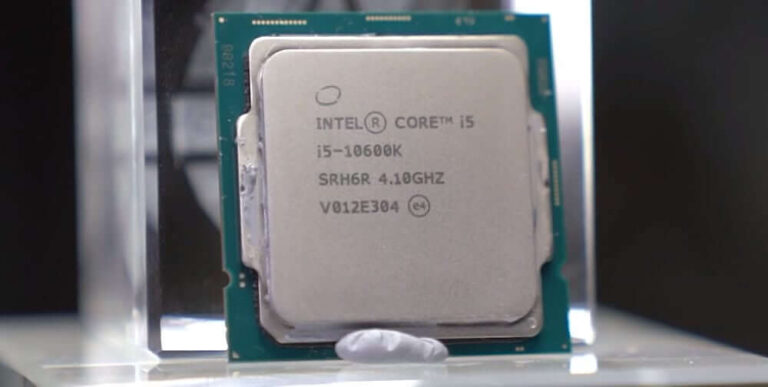
Core i5 is the mid-range processor from Intel. As an upgrade to the Core i3, Core i5 processors definitely offer you more power, whether for gaming or multitasking scenarios. Because depending on the type of applications you are running, you will notice a noticeable difference in speed.
When gaming, you’ll notice the difference between an i3-10100 and an i5-10400 is great (10-25 FPS depending on the game), but if you edit multiple files in Photoshop, you’ll find that the Core i5 can do such tasks faster.
The Core i5 series comes with 6 cores, 12 MB cache, and Hyper-Threading in the current generation. You will benefit from the six cores, especially with multithreaded tasks. Also, with the i5-10600K, you get a processor that you can overclock (there is none in the Core i3 series). Should you have the necessary change, we definitely recommend a Core i5 instead of the rather limited Core i3 processors.
Intel Core i7 Processors

Next up, we have the Intel Core i7 line of processors. Core i7s were the top chips of all processors in the Core series for many years, until the Core i9 and Core X series came out. Nevertheless, the Core i7 series is still quite expensive and clearly in the high-end segment, not just in price.
In the current 10th generation, the i7 series has octa-core performance, virtualization support, Hyper-Threading, and Turbo Boost technology. Also, faster DDR4 RAM of up to 2933 MHz is supported here, with the i3 and i5 only clock rates of up to 2666 MHz are possible.
The main areas of application for Core i7 processors are large multitasking and heavyweight multimedia tasks, high-end gaming, and computationally intensive things such as video editing and rendering. You’ll also see the benefits of an i7 when running multiple virtual machines or editing 4K videos.
i7 processors also have a larger built-in cache that makes repetitive tasks more efficient. Larger caches also mean better multitasking performance.
Should you buy an i7 processor? For the vast majority of you, this is certainly not necessary. For gaming, in particular, it would be much smarter to go with something like an i5-10600K and spend the savings on a better graphics card, more RAM, or even a faster SSD hard drive. However, if you occasionally do CPU-intensive tasks or target 1440p or 4K gaming, the i7 series is an excellent choice.
Intel Core i9 Processors

Finally, we have the ultimate processor series: The Intel Core i9. Initially, there was only the X series for the special LGA2066 socket, but now there are also “normal” i9 CPUs for the LGA1151 socket or currently the new LGA1200.
The X series represents a separate processor series of the Core i9, which was specially designed for computationally intensive application areas and is less useful for gaming. Accordingly, processors with an “X” in their name really only make sense if the system is designed for maximum multitasking performance.
In contrast, the “normal” Core i9 CPUs represent Intel’s processor lineup’s absolute spearhead. At the moment, they are still the most powerful gaming CPUs. Now with 10 instead of just 8 cores, the 10th generation Core i9 CPUs with their 20 MB cache and clock speeds of up to 5.3 GHz offer plenty of power reserves.
In gaming and multithreaded tasks, you get an upgrade compared to a Core i7, but only at an extreme surcharge. Some games can take advantage of the extra threads, and certain benchmarks also benefit from the extra performance from these costly chips. Still, in most cases, the benefit is minimal.
So if you want to equip a workstation for rendering, video editing, or other intense tasks that can use many cores, then a Core i9 is worth considering. Gamers who really want to get the last FPS out will be happy with this – if the budget is not an issue. But an i7 9700K, i5 10600K or i7 10700K is much cheaper and with similar performance. For almost all gamers, the Core i7 is the better choice.
Intel Processors the 10th Generation in Detail
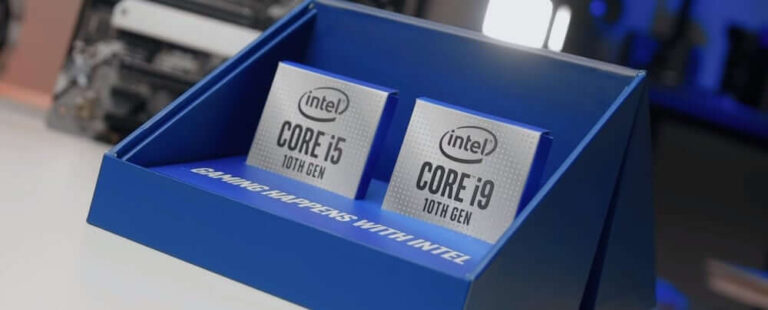
In the following, we would like to introduce you to the differences between the CPU models within the latest generation. This gives you a good idea of how big the distance between the different rows i3, i5, i7, and i9 actually is. We leave out the X series, especially since it is not relevant for gamers.
| Property | i3 | i5 | i7 | i9 |
|---|---|---|---|---|
| Max Base Clock | 3.8 GHz | 4.1 GHz | 3.8 GHz | 3.7 GHz |
| Max Turbo Boost Rate | unsupported | unsupported | 5.1 GHz | 5.2 GHz |
| Single Core Turbo | up to 4.6 GHz | up to 4.8 GHz | up to 5 GHz | up to 5.1 GHz |
| Max Cores / Threads | 4/8 | 6/12 | 8/16 | 10/20 |
| Hyperthreading | Yes | Yes | Yes | Yes |
| Cache | Max 8 MB | Max 12 MB | Max 16 MB | Max 20 MB |
| RAM | Up to DDR4-2666 | Up to DDR4-2666 | Up to DDR4-2993 | Up to DDR4-2993 |
Even with the 10th generation, Intel cannot compensate for its weaknesses outside of gaming and the price-performance compared to the Ryzen 3000 chips from AMD. Nevertheless, some interesting processors are especially interesting for us gamers (more on this below in the recommendations). Unfortunately, even the tenth Intel-Gen cannot yet support PCIe 4.0 and also needs a new mainboard for these CPUs that supports the LGA1200 socket (such as mainboards with the Z490 chipset).
9th Generation Intel Processors in Detail

The 9th generation of Intel CPUs is still relevant in 2020. With the appearance of the 10th generation, prices were reduced and, above all, mainboards for the “old” 1151 socket are becoming cheaper and cheaper. That’s why we wanted to show you the most important differences within this era again.
| Property | i3 | i5 | i7 | i9 |
|---|---|---|---|---|
| Max Base Clock | 4 GHz | 3.7 GHz | 3.6 GHz | 3.6 GHz |
| Max Turbo Boost Rate | 4.6 GHz | 4.6 GHz | 4.9 GHz | 5.0 GHz |
| Max Cores / Threads | 4/4 | 6/6 | 8/8 | 8/16 |
| Hyperthreading | No | No | No | Yes |
| Cache | Max 8 MB | Max 9 MB | Max 12 MB | Max 16 MB |
| RAM | Up to DDR4-2400 | Up to DDR4-2666 | Up to DDR4-2666 | Up to DDR4-2666 |
A clear difference between the tenth and ninth generation is obvious: i3, i5, and i7 CPUs did not have hyperthreading. About the architecture, 14nm was set here, which can also be seen in the latest series. Nevertheless, Intel’s current generation of processors experienced some innovations, which differentiates them from the 9th generation. But if you can find cheap CPUs from Intel’s ninth-generation somewhere, then these are still a solid base.
The Best Intel Processors : Our Recommendations
Now that you have all the details about the latest Intel processors, it is time for us to give you some recommendations. We rummaged through all the price points to show you the right Intel CPU for YOUR budget. Let’s take off!
Best Intel Processor For Gaming & Price Performance: i5-10600K
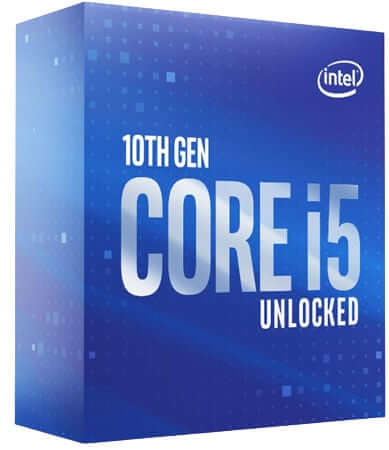
Specifications
- Clock rate: 4.1GHz / 4.8GHz
- Cores & Threads: 6/12
- Socket: FCLGA1200
- TDP: 125W
Description
Intel fans will struggle to find something better in terms of value for money because this thing is absolutely awesome. In fact, it’s so good that the i7-10700K is almost completely irrelevant to current pricing – especially since the 10600K offers pretty much the same performance for less money.
This highly anticipated CPU comes with 6 cores and 12 threads, which means that Intel fans have two fewer cores than the similarly priced 3700X alternative. Although Ryzen has the edge in general benchmarks and multitasking benchmarking, the same cannot be said for games.
The Intel i5-10600K is unbeatable from a gaming standpoint and offers fantastic single-core performance that even comes close to that of the mighty i9-10900K. The i5-10600K can have a base clock frequency of 4.10 GHz or a boost frequency of 4.80 GHz across all cores. Thanks to several different factors, the i5-10600K can be easily trimmed to the level of the i9-10900K with a simple overclock. Of course, you can’t get around a Z490 motherboard for this, but if it’s done right, it’s worth it!
The i5-10600K can even perform some moderately intensive multithreaded tasks such as video rendering and 3D modeling thanks to the additional hyperthreading. All in all, our absolute top recommendation among the Intel CPUs!
Best Affordable Intel Processor: i5-10400F
Specifications
- Clock rate: 2.9GHz / 4.3GHz
- Cores & Threads: 6/12
- Socket: FCLGA1200
- TDP: 65W
Description
Yes, we know there is also the i3-10100, but the i5-10400F offers you so much more for only 40 €. For the most part, we think it’s the best option for anyone on a budget. When it comes to multitasking scenarios, he doesn’t clear as much, but you’re at the forefront when it comes to gaming.
The 10400F is a 6-core processor without a GPU that offers hyperthreading support like the other 10th generation Intel CPUs. It has a base clock frequency of 2.90 GHz, which can be increased to 4.30 GHz immediately.
It’s a pretty good choice for gamers for less intense titles like CS: GO, Rainbow Six Siege, and the like. But even with CPU-heavy titles like AC: Odyssey or Hitman 2, you can easily reach your 90FPS here. In a direct comparison with the Ryzen 3600, the i5-10400F is even slightly ahead, making it a pretty interesting prospect for Intel fans.
But it also has its drawbacks. First of all, it is not overclockable, which means that you have to be satisfied with the boost clock of 4.30 GHz. Also, you don’t get an integrated GPU here, which, of course, means you have additional costs. However, as a gamer, you should install a dedicated graphics card anyway, which makes this unnecessary.
Most Powerful Intel CPU For Enthusiasts: i9-10900K
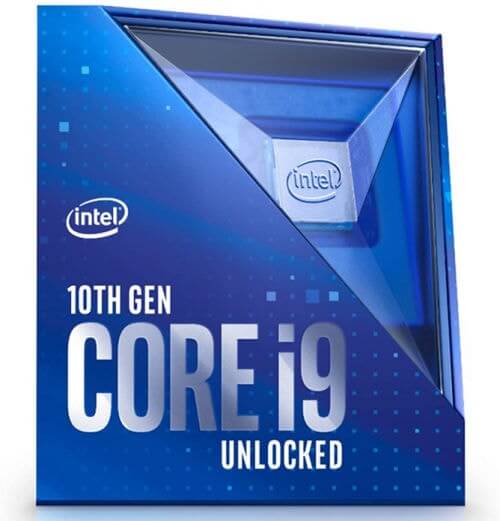
Specifications
- Clock rate: 3.7GHz / 5.3GHz
- Cores & Threads: 10/20
- Socket: FCLGA1200
- TDP: 125W
Description
This 10-core chip with 20 threads is at the top of the performance Olympus. It has a base clock rate of 3.70 GHz and a maximum single-core turbo frequency of 5.30 GHz when the new Velocity Boost algorithm is used. With strong overclocking, even 5.3 GHz can sometimes be reached on all cores.
Intel’s 10-core CPU offers a TDP of 125 watts, but tests show that it can reach up to 325 watts when overclocked. So if you want to get the most out of your Core i9, you need a powerful cooler.
Despite the high power consumption, the Core i9-10900K doesn’t disappoint for the price. It is currently the fastest gaming CPU on the market and, therefore, also the best Intel processor. In some cases, it even outperforms AMD’s Ryzen 9 3900X, a 12-core chip with 24 threads for productivity tasks.
The Core i9-10900K includes 20MB of L3 cache and Intel’s built-in UHD Graphics 630 GPU, although it would be a waste to use those for anything other than testing Windows. When you combine this CPU with a powerful graphics card, you get the most powerful gaming PC that you can buy today.
Best Intel CPU for Workstations: i9-10980XE
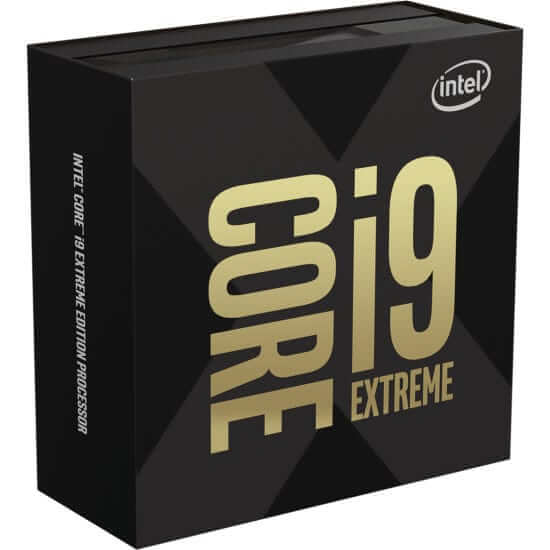
Specifications
- Clock rate: 3.0GHz / 4.6GHz
- Cores & Threads: 18/36
- Socket: FCLGA2066
- TDP: 165W
Description
If you really want to build a high-end workstation with an Intel CPU (we rather recommend AMD), then check out this beast. Intel’s leading CPU for multithreaded tasks is the i9-10980XE – an update of the 9980XE.
Intel’s latest 18-core comes with 36 threads, a base clock frequency of 3.0 GHz, and a boost clock of 4.60 GHz on all cores. This is Intel’s answer to AMD’s latest Threadripper CPUs that keep the multitasking benchmarks tight. While the 10980XE still lags a bit behind its Ryzen counterpart, it’s still Intel’s best CPU when it comes to heavy multitasking workflows.
In terms of benchmarks, the i9-10980XE only marginally outperforms the Ryzen 9 3950X in the standard configuration for Adobe Premiere and Blender’s tasks. Apart from that, users will notice a decent performance jump when overclocking to over 4.5 GHz compared to the similarly positioned Ryzen. In other workflow benchmarks such as Cinebench, AIDA 64, and Handbrake, however, the I9-10980XE loses out.
So if you really want to stay with Intel and need a processor for compute-intensive scenarios, then the i9-10980XE is definitely the right processor.
